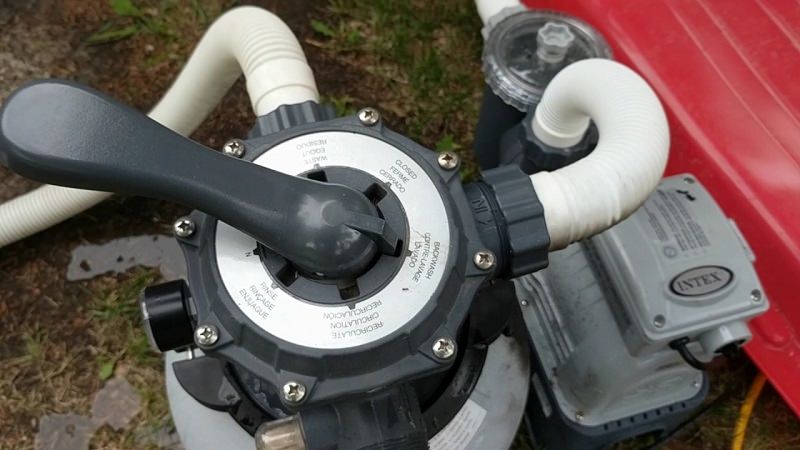
Table of Contents
In order to clean a pool’s filter from trash and debris, pool owners often reverse the flow of the water. “Backwashing” reverses the water’s flow and causes it to push the debris out. Backwashing cleans a pool’s filter so that the owner does not have to clean the filter by hand. The entire process is complete in just a few minutes. Backwashing is complete when the water coming out of the filter runs clear and no more contaminants are seen in the hose.
How do you know when it is time to backwash? All you have to do is check the pool’s pressure. When the pressure gauge indicates about 8 to 10 psi over the “startup” pressure, backwashing is needed.
Dirt Gets Back Into Pool
If soil seems to be passing through the pool’s filter, some things that need to be checked include:
- Broken grids or filters
- Damaged retainers or manifolds
- Bad O-rings or gaskets on the backwash valves
The secret to keeping a clean pool is regular maintenance and prevention. Anytime you feel resistance when turning the backwash valve, open the valve and add lubricant to prevent future leaking. Take time to take a close look at cartridges, manifolds, laterals, and grids when you clean the filter. Take your time when putting the valve back together. Rushing through this process can cause careless errors and future leaks and problems.
Backwashing and Filters
When selecting a filter for your pool, not just any filter will do. Take care to select the appropriate filter for your pool. Each pool and skimmer will require a certain filter that needs to be maintained and cleaned regularly. There are different types of filters so select one that you prefer (in the appropriate size) and keep it clean. One easy to clean option is the cartridge filter.
No matter what you select – be sure the filter fits your pool size.
A DE pool filter can be cleaned temporarily by backwashing. However, for a more thorough, proper cleaning, it must be completely taken apart and cleaned. Backwashing is very simply when you use a sand filter. The sand filter prevents any backwashing that would cause a dirty pool.
How to Backwash a DE Pool Filter
Backwashing a DE pool filter follows these steps:
- Set the pump to the off position and set the backwash valve to the setting – Backwash.
- Set the pump to the on position and watch the glass in the viewer. Notice when the water begins to run clear. Alternate between rinse and backwash several time to remove more DE. Remember: the pump should be turned off before you change valve settings.
- Place any collected DE in an appropriate waste receptacle. Some pools feature a separate DE collection tank.
- Set the pump to the off position and ensure that the pump will not turn back on while the filter is disassembled.
- Allow the filter to drain by opening the release valve and allowing water to flow out. If you want a more complete draining, take out the drain plug near the bottom of the filter. This allows the water to drain from the bottom of the tank.
How Often Should You Backwash Your Pool Filter?
No certain time for backwashing and tearing down can be established. The timetable for this depends on how often the pool is used and how dirty it gets with use. Usually DE filters require cleaning at least 6 times each year.
Backwashing should not be needed any more frequently than the regular maintenance timeframe unless the pool gets very dirty.
Some pool manufacturers recommend that you want the pressure gauge to determine when the backwash. When the pressure is at 8 to 10 psi over the starting level, they propose that you backwash. Anytime there is a big storm or an algae outbreak in your pool, backwashing is in order.
Pool owners will need to backwash about once a month with a sand filter. Plan to completely disassemble the sand filter for a complete cleaning about twice annually.
How to Backwash a Sand Pool Filter
Backwashing a sand filter follows these steps:
- Turn the system to the off position.
- Crimp the backwash hose to cut off access to the water outlet.
- Set the backwash hose to pull or push so that the water flows easily through the hose.
- Set the handle to the Backwash position.
- Allow the system to run for a few minutes until the water runs clear.
- Set the system to off to end the backwash procedure.
- Secure the hose by rolling it up.
- Reset to the previous setting on the valve handle. This allows the water to flow through the system again. Secure it in place.
- Open the valve at the top of the filter for air relief. Let this valve remain open until the water is flowing through.
- Set the valve to the closed position and turn off the system.
- What is a DE Pool Filter?
- Best DE Pool Filters
- Best Sand Filters for Above Ground Pools
- Best Above Ground Pool Filters
- Cleaning Algae from a Pool
- The Best Way to Clean Pool Tile at the Waterline
- 7 Reasons to Get a Pool Cover
- Best Robotic Pool Cleaners
- Best Suction Pool Cleaners
- Best Pressure Side Pool Cleaners